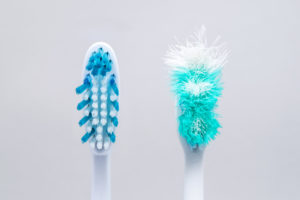
Do you know when to change your toothbrush? Even though most of us clean our teeth with these useful tools every day, it’s easy to forget that they’re not designed to last forever. If you take a close look at your toothbrush and discover that it has flattened, frayed, or discolored bristles, it may be spreading bacteria instead of cleaning it away. Here’s what could happen if you continue to use an old toothbrush and how often you should replace it to keep your smile happy and healthy.
Old Toothbrushes & Oral Health Issues
As toothbrushes wear down over time, their bristles become bent and skewed. Researchers have found that after several months of use, toothbrushes begin to leave behind a considerable amount of plaque, bacteria, and food debris after brushing for a full two minutes. What’s more, frayed and flattened bristles create spaces that can trap and harbor bacteria, even after you rinse off your toothbrush when you’re done brushing. Not only does this allow bacteria to grow on the damp bristles of your toothbrush between uses, but accumulated particles can be redeposited back into your mouth the next time you brush. This influx in plaque and bacteria in your mouth can lead to:
- Bad breath
- Discolored teeth
- Tooth decay
- Oral infections
- Gum disease
Signs That It’s Time to Change Your Toothbrush
After numerous studies on the lifespan and efficiency of toothbrush bristles, the American Dental Association and other dental experts agree you should replace your toothbrush at three key times:
- After three to four months of use.
- When the bristles begin to look frayed, flattened, or discolored.
- Once you’ve recovered from having the flu, a cold, or other sickness.
Choosing Your Next Toothbrush
When the time comes to replace your toothbrush, you’ll have several options to choose from. Traditional manual toothbrushes are cost-effective and widely available. They’re an easy-to-use option that come in a variety of styles to suit individual brushing preferences. Alternatively, you could choose a modern electric toothbrush. These are an excellent choice for those with limited mobility or who could benefit from extra features such as built-in timers, sensors, and modes.
Whichever type of toothbrush you choose, remember—the most effective toothbrush will be the one you remember to use! Be sure to pick a product that has the American Dental Association’s Seal of Approval and soft bristles for the most reliable results. A small investment in a new toothbrush every few months can go a long way for the health, appearance, and wellbeing of your smile!
About the Author
Dr. James Kramer has been helping the smiles of Selbyville, DE stay happy and healthy for over three decades. With thousands of hours of completed continuing education under his belt and an esteemed Mastership in the Academy of General Dentistry, he is proud to offer his patients the high-quality and compassionate dental care they deserve. During your biannual checkup and cleaning, he’ll be happy to help you choose the right dental products to make the most out of your at-home oral hygiene routine. To learn more about toothbrushes, he can be contacted via his website or at (302) 436-5133.
